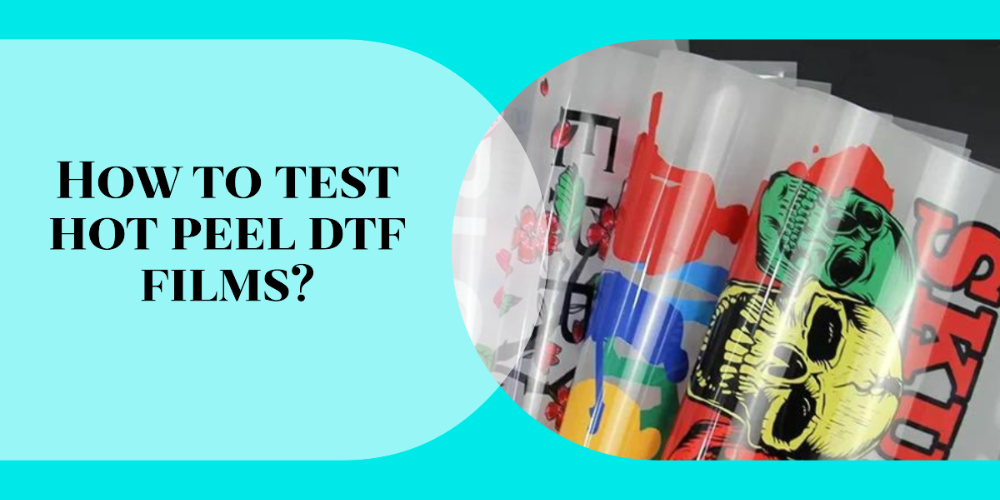DTF film, tailored for Direct-to-Film printing, serves as a crucial medium for transferring inkjet-printed designs from DTF printers onto textile materials through heat pressing. This premium film is distinguished by its superior ability to hold ink, efficient powder removal, and effortless peeling qualities. Selecting an optimal DTF film is vital for any printing venture as it significantly influences the overall quality of the prints.
Mad Monkey Transfers, committed to offering top-quality products, values maintaining open communication with customers to grasp their requirements and challenges in using Direct-to-Film (DTF) technology. This collaborative approach aids in enhancing and evolving DTF methods. Recently, customers have sent us samples of hot peel DTF films from various brands. Our technical experts conducted comparative tests with these samples alongside our latest 100μ hot peel DTF film. From these tests, we have compiled key insights and observations to assist you in making informed decisions when purchasing DTF films.
Appearance
Thickness conformance
During our sample testing, the initial aspect we examined the thickness of the DTF film. While numerous products in the market claim a thickness of 100μm in their specifications, some manufacturers may compromise in the coating process. For instance, the image below showcases a sample received from a different brand, where the actual thickness measured was approximately 89μm. This inconsistency can have implications for retail branding marketing, as the quality of the film directly impacts the final product presentation and brand image.

*Testing whether the thickness of the film is up to standard.
DTF films are constructed with a foundational PET layer, topped with a release layer and an ink-absorbing layer. Custom DTF films, from Mad Monkey Transfers incorporate a backside coating for anti-static and anti-adhesive continuous processing. Our hot peel DTF film comprises five distinct layers: a silicone protective coating, a PET base layer, a hot peel coating, an ink absorbing layer, and a water absorbing layer. Due to its multi-layer coating, the DTF PET film appears less transparent and exhibits a hazy, frosted texture.
Base Film Performance
The base film of DTF PET film is required to be resistant to high temperatures. It's possible that some films appear flawless post-printing, but during the heat press transfer process, they may curl or even melt if they lack sufficient heat resistance. Such instances can lead to damaging the garment fabric, resulting in significantly adverse outcomes.
Coating quality
The quality of the coating is crucial for achieving optimal print results. Uneven coatings or those contaminated with impurities can significantly impact the final print quality. It's essential to check for a uniform and fine surface coating. An uneven coating can result in irregular ink distribution, leading to a noisy or mottled appearance in the printed pattern. Additionally, poor-quality coatings on custom DTF transfer films might seem acceptable initially, but they can lead to inadequate ink absorption. This can cause the ink to bleed off the film, potentially soiling the printer, as well as your hands and clothing.

* Poorly ink-absorbent DTF film will cause ink bleeding.
DTF transfer films with quality coating need to have the following characteristics:
High ink carrying capacity: Even at high pass printing, the ink remains stable and does not flow.
Precision in fine lines and colors: The ink adheres cleanly to the film, allowing for sharp, smudge-free printing of very fine lines.
Effective powder removal: After the dithering process, no excess DTF powder sticks to unprinted areas, ensuring prints with smooth edges.
Easy peel-off capability: The DTF film includes a stable and uniformly applied release layer, guaranteeing that the backing film peels off smoothly without any sticking.
Ink absorption capacity
In our sample tests, we assess the ink carrying capacity of DTF films by setting the pass number to its maximum. If a DTF film has a substandard ink-absorbent or water-absorbent layer, it might exhibit bleeding of ink, color, or water during the printing process.
Printing of blocks lines and Gradients
The level of print quality plays a crucial role in DTF quality assessment. It serves as an indicator of the uniformity of the film coating. Typically, we opt for testing using color blocks or delicate lines. Additionally, we recommend incorporating gradient color test patterns for evaluation.

*Noise may appear on the printed pattern if the coating of DTF film is not uniform.
Residue on pattern edge after powder shaking.
After shaking the powder, certain samples may exhibit residual powder along the pattern's edges. This residue can result in the presence of hot melt glue traces on the edges of your transferred design, adversely affecting its aesthetic appearance. In contrast, a film with effective powder shaking will display cleanly printed patterns without any residue along the edges.

*Comparison of shaking powder with and without residue.
Transfer and peeling
High-quality DTF films exhibit easy peel-off characteristics after pressing, while lower-quality ones tend to be tough to tear or can damage the printed pattern. This distinction becomes particularly critical in the case of DTF films known as "hot peel," where the demands on the release layer's performance are elevated. Our 100μ hot peel DTF film boasts superior raw materials in its release layer, facilitating effortless and immediate peeling post-pressing. This not only ensures the stability and uniformity of print quality but also enhances the overall user experience.
If you're still uncertain about your choice, we invite you to send us samples for evaluation. Our technical experts will conduct complimentary tests and provide you with well-founded purchasing recommendations. Should you have any inquiries or require further assistance, please don't hesitate to get in touch with us.

